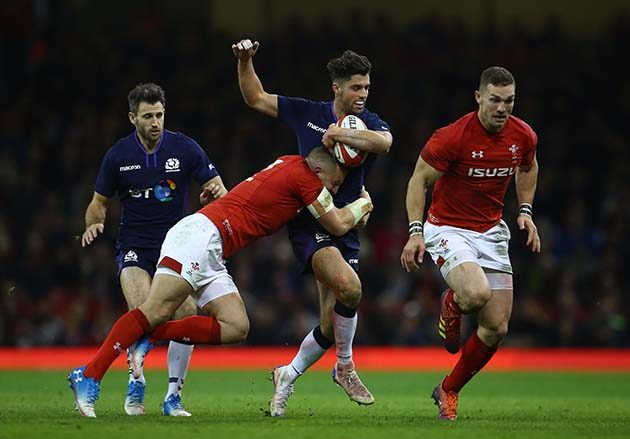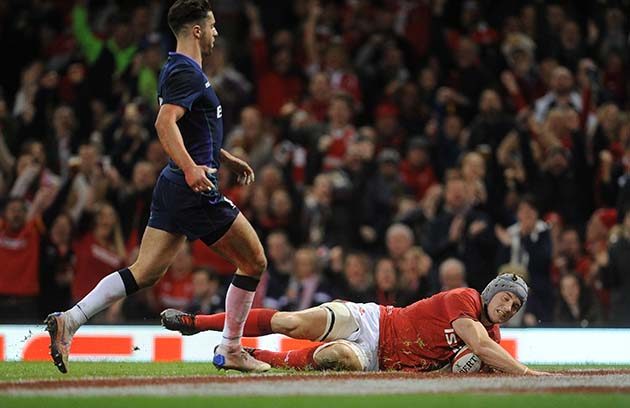Paul Williams reflects on the big talking points from the opening weekend of the 2018 autumn Internationals
Wales backs no longer reliant on power – but it’s there
Three years ago, power through contact was all that the Wales back-line had. Thanks to the selection of players like Hadleigh Parkes, Steff Evans and Liam Williams, as well as a change in approach from Leigh Halfpenny, that is no longer the case.
However, as the Welsh back-line proved against Scotland, the power is still there and when turned up to 11 it is devastating.

Central figure: Hadleigh Parkes tries to get past Hamish Watson (Getty Images)
After two or three mixed seasons, George North has become George North 2.0. Against Scotland he carried the ball only 33 metres, which is low for a wing. But when you consider that most of those yards were achieved with Scottish people hanging off his back, it is remarkable.
His try was YouTube worthy. With players clinging onto his shorts and limbs, he looked like a husky dragging a balsa wood sleigh.
Take a look at George North's try earlier today during Wales' 21-10 victory over Scotland in their first autumn international
Watch: https://t.co/Ydo8DMebVK pic.twitter.com/aHF9UjRRLF
— BBC Sport Wales (@BBCSportWales) November 3, 2018
But the power game in the Welsh back-line didn’t end with North. Jonathan Davies had one of those games where he looked like he was handing off shop mannequins, not 16st men. His fend on Huw Jones was so devastating that it led Gregor Townsend to single him out in the post-match press conference.
Game clock can’t dictate refereeing decisions
Before we cut open the carcass and dissect Owen Farrell’s tackle, let’s start by stating that refereeing elite rugby is the second most thankless job in the world – working on Donald Trump’s PR team being the first.
But whilst recognising that Angus Gardner was placed in a difficult scenario at the end of the England v South Africa game, where the tackle decision could decide the game, we cannot ignore the significance of the call and particularly the timing.
Whether you think the hit was worthy of no sanction, a penalty, yellow or red, if the tackle had happened in the first third of the game the outcome could well have been different.
Related: Owen Farrell’s tackle divides opinion
Farrell’s tackle was of the Venus de Milo type – plenty of shoulder, a touch of bicep and no forearm. Rugby union is no longer the same game as it was in the 1980s and neither is it comparable to rugby league, so any comparisons with the former are pointless. Using modern-day interpretations, it was a penalty, probably no more than that.

Flashpoint: Owen Farrell tackles Andre Esterhuizen (Getty Images)
Had the incident happened at any point other than in the last minute of the game, South Africa would have most likely had a shot at goal.
The upshot is that not only are players and supporters bewildered by tackle interpretations, but that those interpretations are also affected by the game clock. It’s as confusing as it is annoying.
Jordan Larmour takes another step forward
Jordan Larmour’s career took another big step forward by taking about 35 steps to the left and to the right for Ireland against Italy in Chicago.
Related: Jordan Larmour scores hat-trick against Italy
Admittedly it was against an understrength Italian team, but it shouldn’t taint what was a Rieko Ioane/Kurtley Beale-type performance from Larmour. He made six clean breaks and beat 12 defenders. Yup, 12.
To beat four defenders means that you had a good game. Six defenders slain indicates an excellent performance. Whereas 12 is the type of number that Kim Jong-un’s advisors would attribute to their leader should he ever play (he looks like a loosehead to me).

Dancing feet: Jordan Larmour makes a break against Italy (Getty Images)
It is understandably difficult for Larmour to break into the current Irish back-line. Such is the consistency of Rob Kearney, Keith Earls and Jacob Stockdale that a starting berth looks unlikely until after the Rugby World Cup. But as we head towards Japan 2019, he is beginning to look like the best bench player in the world.
Boks’ blueprint is back and it is working
South Africa may have lost at Twickenham, but after a three-season rebuild, they are back. And the manner in which they’re ‘back’ is important.
As well as the understandable and necessary player quotas, the Boks have been sidetracked by trying to change their blueprint and copy the Kiwis. But thankfully it looks like they are reverting to the Bok way: big carriers, carrying big.
When you have Eben Etzebeth, Pieter-Steph du Toit, Siya Kolisi and Duane Vermeulen you don’t really need a rapid offload game. Why risk an offload when the metres gained after the tackle are so big? And when Etzebeth was substituted, they brought on RG Snyman – a man so big that his skull is the same size as my first car.
The most effective changes against England were in the centre. Damian de Allende and Jesse Kriel are often derided in South African rugby because they can’t pass and offload like Sonny Bill Williams or Jack Goodhue, but when your centre partnership is carrying nearly 100 metres and beating eight defenders it doesn’t matter.

Big impact: Damian de Allende was a big performer for the Boks at Twickenham (Getty Images)
It’s not as if the Boks don’t have creative players in the back three. S’busiso Nkosi, Damian Willemse and the ever impressive Aphiwe Dyantyi provided plenty of steps and slides against England. And with Faf de Klerk and Willie le Roux backstage, the creativity levels can be dialled up further. The Boks are back and it’s great to see.
It wasn’t a good day for creative Scotland
At the moment, Scotland are probably many supporters’ second favourite Test team. As with Glasgow, the style of rugby that they play is pleasing to the eye. ‘Steppy’ full-backs and triple-threat outside-halves, in Finn Russell and Adam Hastings, mean they’re a team heavy on line breaks, offloads and the resulting tries.

Tough day: Adam Hastings is thwarted by the Welsh defence (Getty Images)
But. And there is a but. When the forward platform doesn’t function, as it didn’t against Wales, there is no ‘option b’. To say that Scotland’s pack was shut down by Wales would be a dramatic overstatement – nearly as dramatic an overstatement as Eddie Jones stating that the rugby media want him sacked.
Scotland carried for 420 metres v Wales’ 294. Scotland had 60% of the ball and 64% of the territory. And Hamish Watson had the sort of devastating performance that makes you wonder if he has any power tools at home – he probably just uses his head.
However, when Wales slowed down Scotland’s ruck speed, which Justin Tipuric, Ken Owens and Dillon Lewis did to great effect, the heavy carries just weren’t enough to get them over the gain-line. Scotland will improve this autumn. We can be sure of that.
Follow Rugby World on Facebook, Twitter and Instagram.





